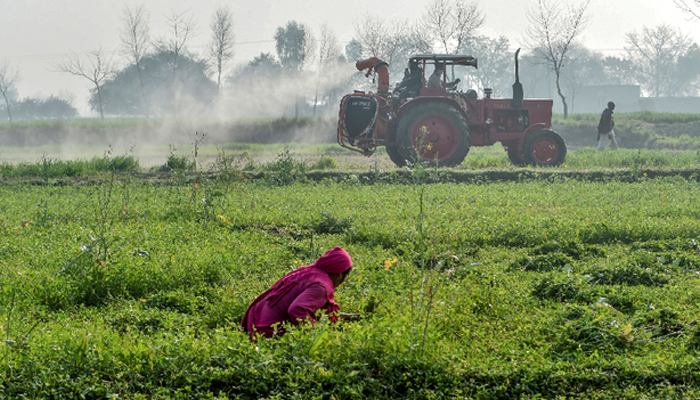Gen Ayub Khan’s legacy sprouts again: The four pillars of Gen Asim Munir’s New Green Revolution
Chemical pesticides were introduced and effective control of pests and diseases contributed to overall increase in wheat and rice production
In 1960, our wheat production stood at 3.35 million tonnes. The advent of Ayub Khan’s Green Revolution marked a transformative era. By 1982, our wheat output quadrupled, reaching an impressive 12 million tonnes. Similarly, in 1960, rice production amounted to 2.24 million tonnes.
With the introduction of Ayub Khan’s ‘Green Revolution’, our rice production experienced a remarkable surge. By 1982, it had increased by 140%, reaching a substantial 5.37 million tonnes.
Here are the four key drivers behind Ayub Khan’s Green Revolution: High-Yielding Varieties (HYVs), fertilizers, pesticides, and irrigation. HYVs produced more grains per plant and the use of fertilizers significantly boosted the growth and productivity of wheat and rice crops.
Chemical pesticides were introduced and effective control of pests and diseases contributed to the overall increase in wheat and rice production. Improved irrigation practices, including the construction of dams, canal systems and tube wells played a crucial role in enhancing water availability for wheat and rice cultivation.
General Asim Munir has expressed his desire for a ‘New Green Revolution’. Drawing on lessons from the first Green Revolution under General Ayub Khan and considering Pakistan’s current agricultural landscape, here are crucial facts General Asim Munir would likely need to address: biotechnology and genomics, digital agriculture, smart water management and organic and regenerative agriculture.
A ‘New Green Revolution’ is unattainable without the utilization of genomics tools, essential for identifying genes associated with drought tolerance, heat stress resistance and disease resistance. A ‘New Green Revolution’ is going to need digital agriculture technologies, including sensors, drones and data analytics. We would have to enable our farmers to monitor real-time data on soil health, water levels, precise and targeted applications of fertilizers, water and pesticides, minimizing waste and optimizing the use of resources.
Smart water management is poised to be the primary catalyst for Pakistan’s upcoming Green Revolution. The essential components include precision irrigation, characterized by targeted water application, alongside rainwater harvesting and water reuse – forming the foundational prerequisites for the ‘New Green Revolution’. Organic practices and regenerative techniques hold substantial promise for ushering in a New Green Revolution.
These approaches not only foster enhanced yields but also contribute to bolstering food security. General Ayub Khan’s Green Revolution was a monumental leap. With fertile minds and cutting-edge tools, General Asim Munir’s ‘New Green Revolution’ can be a quantum jump. Imagine drones sowing climate-resistant seeds, sensors whispering to crops, and water dancing to a digital tune. Pakistan’s fields are thirsty for progress. Pakistan’s fields will bloom with abundance. Pakistan’s fields will nourish not just bellies, but a nation’s dreams.
-
 What's Buzzing Around TikTok's 'PineDrama' App: Everything You Need To Know
What's Buzzing Around TikTok's 'PineDrama' App: Everything You Need To Know -
 Who’s Next After Australia’s Under-16s Social Media Ban?
Who’s Next After Australia’s Under-16s Social Media Ban? -
 Do You Have Depression Or Is It Just Monday Blues? Find Out Where Science Stands
Do You Have Depression Or Is It Just Monday Blues? Find Out Where Science Stands -
 Why Claude Is Gaining Momentum In Revolutionizing The AI Landscape
Why Claude Is Gaining Momentum In Revolutionizing The AI Landscape -
 Elon Musk Unveils Plans To Take Humanity To The Moon And Mars
Elon Musk Unveils Plans To Take Humanity To The Moon And Mars -
 Air Pollution May Play A Role In Prostate Cancer Risk, Experts Warn
Air Pollution May Play A Role In Prostate Cancer Risk, Experts Warn -
 Royal Expert Reveals Real Reason King Charles Won't Meet Prince Harry Next Week
Royal Expert Reveals Real Reason King Charles Won't Meet Prince Harry Next Week -
 Ansel Elgort Welcomes His First Baby In Secret
Ansel Elgort Welcomes His First Baby In Secret -
 Startup Aims To Brighten Night Skies With Space Mirrors
Startup Aims To Brighten Night Skies With Space Mirrors -
 Cheaper Cars, Fewer EVs: Trump Administration Shifts ‘auto Policy’ Focus
Cheaper Cars, Fewer EVs: Trump Administration Shifts ‘auto Policy’ Focus -
 Meghan Markle Takes 'breadwinner' Role In Prince Harry's California Life
Meghan Markle Takes 'breadwinner' Role In Prince Harry's California Life -
 Type 2 Diabetes Hidden Trigger In Daily Food Revealed
Type 2 Diabetes Hidden Trigger In Daily Food Revealed -
 Vertical Tabs Coming To Google Chrome
Vertical Tabs Coming To Google Chrome -
 Jane Seymour Reveals THIS Beloved Romance Was 'worst-reviewed' Movie Ever
Jane Seymour Reveals THIS Beloved Romance Was 'worst-reviewed' Movie Ever -
 European Leaders Slam Trump’s Tariff Threat Over Greenland As ‘unacceptable’
European Leaders Slam Trump’s Tariff Threat Over Greenland As ‘unacceptable’ -
 Princess Eugenie Leaves Father Andrew 'devastated' With Big Step: 't's Brooklyn Beckham Level'
Princess Eugenie Leaves Father Andrew 'devastated' With Big Step: 't's Brooklyn Beckham Level'




